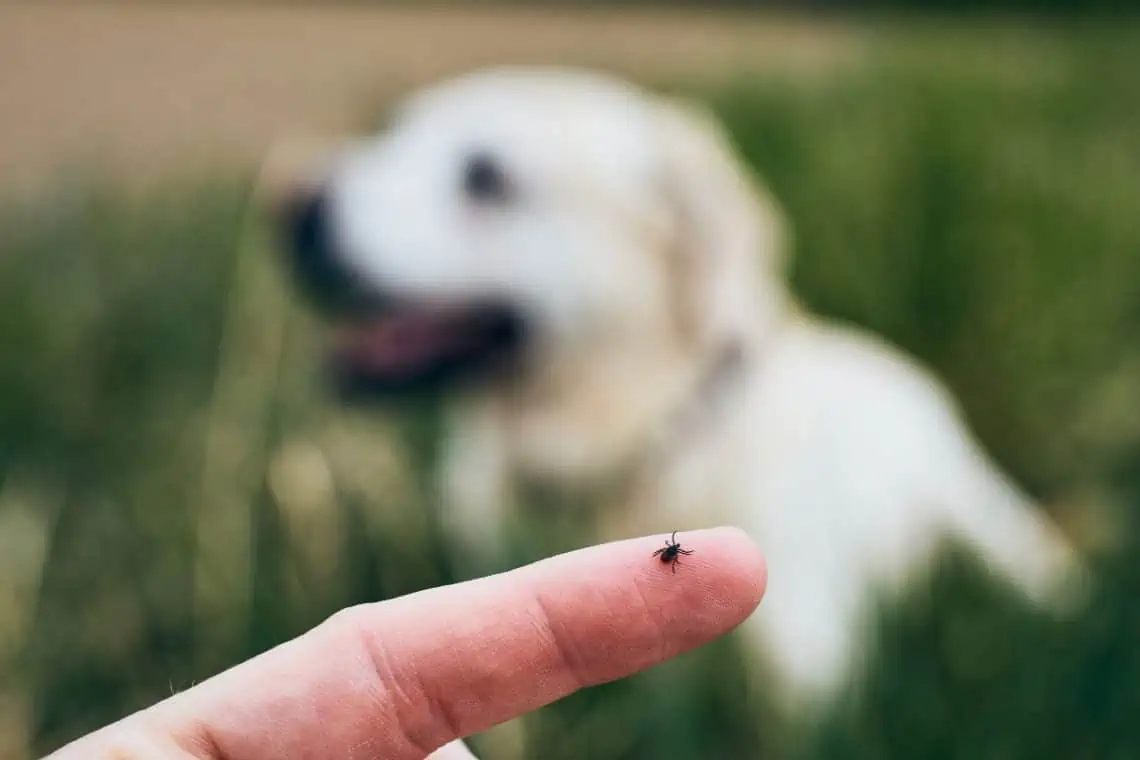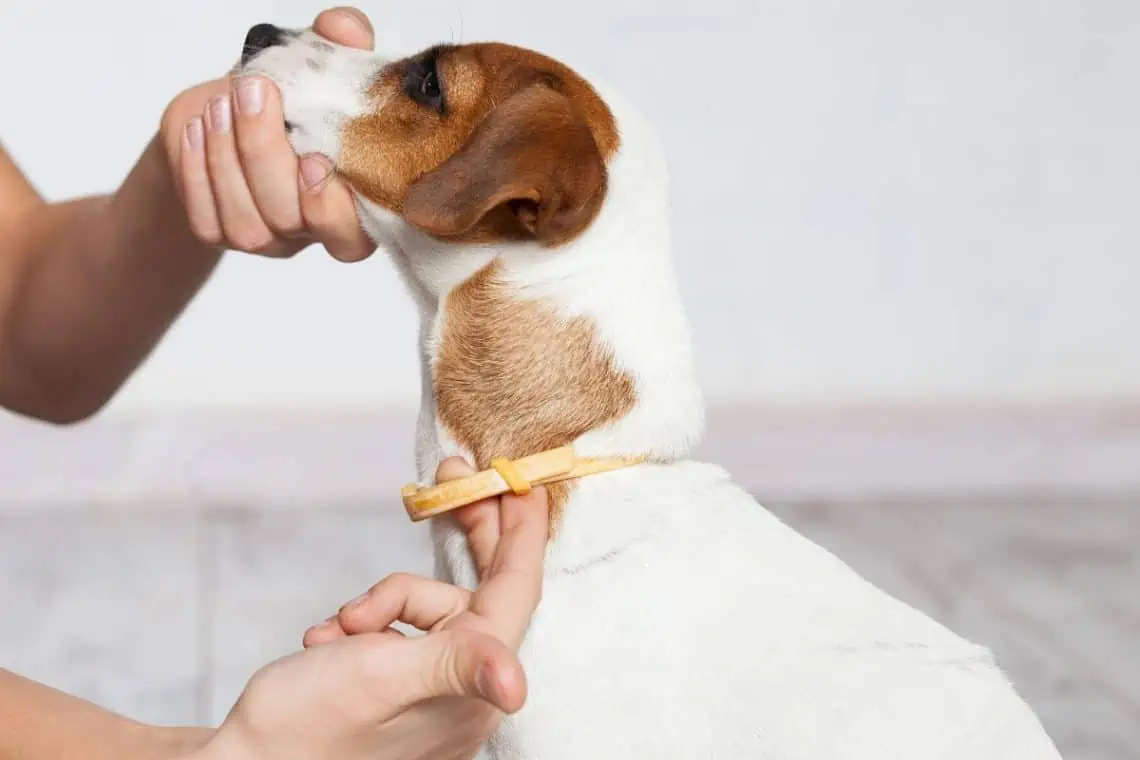One of the major concerns of pet owners is how to keep their furry friends free from fleas. Flea collars are the most common means of flea treatments because it is considered the easiest way to provide flea protection to your pet, but it may not necessarily be one of the best ways.
So let’s dive into answering the question, “Are flea collars safe for puppies?”, by explaining the various types of flea collars, their ingredients, and how they work.
We’ll also highlight the potential risks associated with flea collars, any allergies or adverse reactions to their use, and any safety precautions owners should consider when using flea collars on puppies.
How Does a Dog Flea Collar Work?
Flea collars work by releasing a slow-release insecticide that kills adult fleas. The insecticide is absorbed into the pet’s skin and fur, and it kills fleas that bite the pet. Most flea collars also contain an insect growth regulator (IGR), which prevents flea eggs and larvae from developing.
However, flea collars are not 100% effective at killing all flea life stages. Some fleas may be able to avoid contact with the insecticide, and some flea eggs and flea larvae may be able to develop into adults before the IGR can kill them.
If you have a severe flea infestation, you should consider using a combination of flea control methods, such as a flea collar, a topical flea treatment, regular bathing, along with vacuuming and washing of your pet’s bedding several times a week.
Types of Flea Collars
There are two types of flea collars available in the market, chemical-based and natural-based.
Chemical-based flea collars work by releasing active ingredients that get absorbed into the dog’s skin, which then acts to kill the fleas.
Some of the most common types of chemical based flea collars:
- Insecticide-treated collars: These collars release a slow-release insecticide that kills adult fleas.
- IGR-treated collars: These collars release an insect growth regulator (IGR) that prevents flea eggs and larvae from developing.
- Combination collars: These collars contain both an insecticide and an IGR.
On the other hand, natural-based flea collars release essential oils, such as citronella or lemongrass that repel fleas and prevent their infestation.
When it comes to the safety of puppies, most veterinarians advise dog owners to go for natural-based flea collars since they are less toxic.
Do Flea Collars Also Help with Tick Control? How?
Dog owners be aware: Lyme disease is not only a threat to your four-legged friend but also a potential health risk to you. Carried by infected ticks, Borrelia burgdorferi bacteria can transfer from tick bites to both dogs and humans. Ticks that transmit Lyme disease are commonly found in wooded areas but also in tall grass and near water.

When infected with Lyme disease, dogs display varying symptoms depending on the severity of the infection, including fever, loss of appetite, lethargy, lameness, swollen lymph nodes, joint pain, and skin rash. Keep your pooch protected by taking preventative measures against ticks.
There are a number of things you can do to prevent Lyme disease in your dog:
Use a tick prevention product. There are a number of tick products available that can be used as a tick preventative. These products include topical treatments, collars, and oral medications.
Check your dog for ticks regularly. Even if you are using a tick prevention product, it is important to check your dog for ticks regularly. Ticks can be found anywhere on your dog’s body, but they are most commonly found in the following areas:
- Ears
- Head
- Neck
- Legs
- Underbelly
Remove ticks immediately. If you find a tick on your dog, remove it immediately using a pair of tweezers. Be sure to grasp the tick as close to the skin as possible and pull it straight out. Do not twist or jerk the tick, as this can cause the head to break off and remain in your dog’s skin.
Avoid tick-infested areas. If you can, avoid taking your dog to areas where ticks are common, such as tall grass, wooded areas, and near water.
Treat your pet’s yard for ticks. If you have a yard, you can treat it for ticks with a pesticide or insect growth regulator. This will help to avoid a tick infestation in your yard and make it less likely that your pet will come into contact with them.
If you suspect that either you or your pet have been infected with Lyme disease, seek medical attention immediately. Left untreated, Lyme disease can become very serious and lead to long-term health complications for both people and pets alike.
Stay ahead of tick season by taking preventative measures against this potentially dangerous disease!
Choosing the Best Flea Collar For Your Puppy
When choosing a flea collar, it is important to consider the following factors:
- Your pet’s size: Flea collars are available in a variety of sizes to fit different pets. Small dogs will require a different collar than large dogs.
- Your pet’s age: Some flea collars are not recommended for young puppies or kittens.
- Your pet’s health: If your pet has any health problems, you should talk to your veterinarian before using a flea collar.
It is also important to follow the instructions on the flea collar label carefully. Flea collars should be replaced every 3-6 months, or sooner if your pet becomes wet or soiled.

Chemicals to Avoid
Some flea collars contain harmful chemicals such as pyrethroids, which are toxic to puppies. Puppies have a more sensitive and delicate system, which makes them more susceptible to illnesses and adverse reactions from certain chemicals.
Therefore, it’s important to read the ingredients list of the flea collar before using it on your puppy. Some of the common ingredients to avoid include tetrachlorvinphos (banned by the EPA for use in pet collars), propoxur, dichlorvos, and carbaryl.
Part of being a good dog owner is keeping up on newly reported findings for products we may be using with our fur babies. For instance, according to a new congressional report findings, the highly popular Seresto collars are linked to almost 100,000 incidents and 2,500 pet deaths.
Flea Collar Allergic Reaction Symptoms
Puppies can develop an allergic reaction to flea collars, just like humans to certain things. Keep a vigilant eye out for signs of sensitivity. Symptoms of an allergic reaction can include redness, skin irritation, and itching.
In such a situation, it’s best to remove the collar immediately and consult with your veterinarian.
Some dogs may also develop other side effects, such as lethargy, drooling, vomiting, and seizures.
Puppy Flea Collar Safety
When using a flea and tick collar on puppies, safety precautions must be taken by pet owners. Always follow the instructions provided on the label and ensure the proper fit on your dog’s neck.
Don’t allow the puppy to chew or bite at the collar, as it can cause the collar to break or get stuck in their mouth. Also, remember to remove the collar during bath times, and never use flea collars on puppies that are pregnant or nursing.
Personally, if I had young children in the home, I would skip the flea collar as it may be too easily exposed to toddlers and babies who may touch or ingest the ingredients.
Pregnant women should also avoid direct contact with flea collars.

Summary of Tips for Pet Parents
- Always keep the puppy on a regular grooming routine, such as brushing their fur and checking for fleas. A flea comb is your best friend!
- Keep their sleeping area clean and vacuum the house regularly to prevent fleas from multiplying.
- Use natural remedies such as apple cider vinegar or essential oils such as peppermint or eucalyptus to repel fleas.
- Consider consulting with your veterinarian to identify the best flea treatment for your puppy, especially if the puppy has any pre-existing health conditions.
In conclusion, flea collars can be safe and effective flea treatment option for puppies, but only if you, the pet owner, takes the necessary precautions.
Always go for natural-based flea collars and avoid chemical-based options that contain toxic ingredients. It’s also crucial to keep an eye for any allergies and adverse reactions to flea collars.
Lastly, follow the instructions provided on the label, and use flea collars with care to prevent any accidents. But remember, flea prevention is always better!